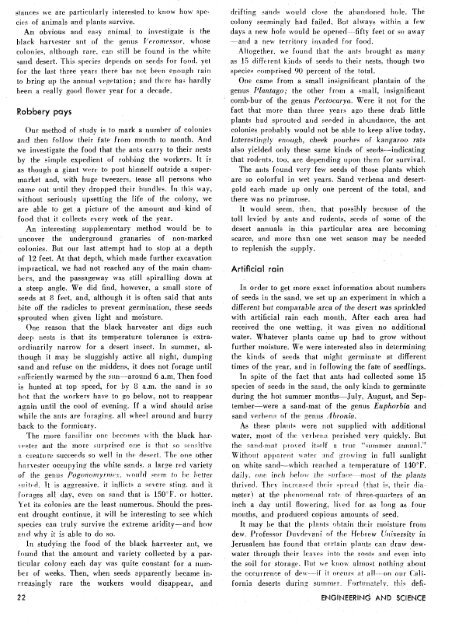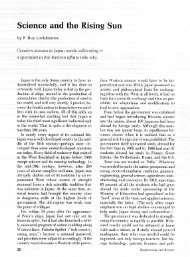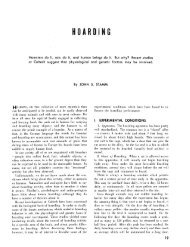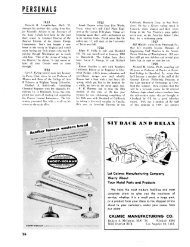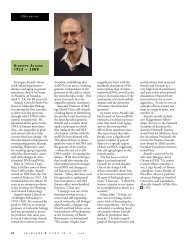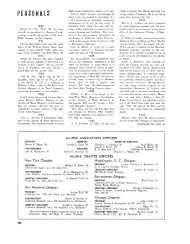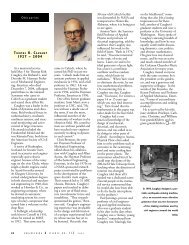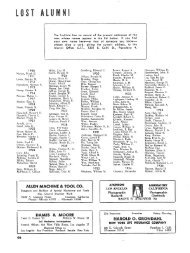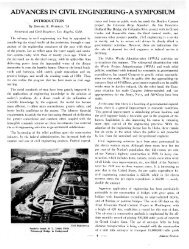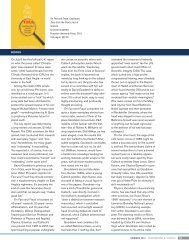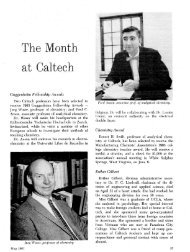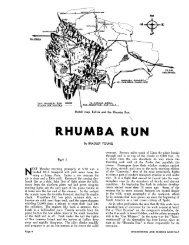PDF - Engineering & Science - California Institute of Technology
PDF - Engineering & Science - California Institute of Technology
PDF - Engineering & Science - California Institute of Technology
You also want an ePaper? Increase the reach of your titles
YUMPU automatically turns print PDFs into web optimized ePapers that Google loves.
star~ve" we are particularly interested to know how specieq<br />
<strong>of</strong> animals and plants survive.<br />
An obvious and eay nnimal to investigate is the<br />
black harvester ant <strong>of</strong> the gemis Vf,rorrr~~ssor, tthose<br />
colonie~, although rare. can "till be found in the white<br />
sand desert. This specie" depends on seeds for food. yet<br />
for the last three years there has not been enough rain<br />
to bring up the annual vegetation; and thtre ha- hardly<br />
tieen a really good flowrr year for a decade.<br />
Robbery pays<br />
Our method <strong>of</strong> study is to mark a number <strong>of</strong> colonies<br />
and then follow their fate frorn month to month. And<br />
we investigate the food that the ants carry to their nests<br />
by the simple expedient <strong>of</strong> robhing the workers. It is<br />
as though a giant were to post himself outside a supermarket<br />
and, with huge tweezers. lease all persons who<br />
came out until they dropped their bundles. fn this way,<br />
without seriously upsetting the life <strong>of</strong> the colony, we<br />
are able to get a picture <strong>of</strong> the amount and kind <strong>of</strong><br />
food that it collects every week <strong>of</strong> the year.<br />
An interesting supplementary method would be to<br />
uncover the underground granaries <strong>of</strong> non-marked<br />
colonies. But our last attempt had to stop at a depth<br />
<strong>of</strong> 12 feet. At that depth, which made further excavation<br />
impractical, we had not reached any <strong>of</strong> the main chambers,<br />
and the passageway was still spiralling down at<br />
a steep angle. We did find, however, a small store <strong>of</strong><br />
seeds at 8 feet, and, although it is <strong>of</strong>ten said that ants<br />
bite <strong>of</strong>f the radicles to prevent germination, these seeds<br />
sprouted when given light and moisture.<br />
One reason that the black harvester ant digs such<br />
deep nests is that its temperature tolerance is extraordinarily<br />
narrow for a desert insert. In summer, although<br />
it may be sluggishly active all night, dumping<br />
sand and refuse on the middens, it does not forage until<br />
mfliriently warmed hy the sun--around 6 a.m. Then food<br />
is hunted at top speed, for by 8 a.m. the sand is so<br />
hot that the workers have to go below, not to reappear<br />
again until the cool <strong>of</strong> evening. If a wind should arise<br />
while the ants are foragin~. all whe~l around and hurry<br />
back to the formicary.<br />
The more faniiliar one become- m ith the black har-<br />
~wtcr ant the more '-iiipriwl ow is that GO


